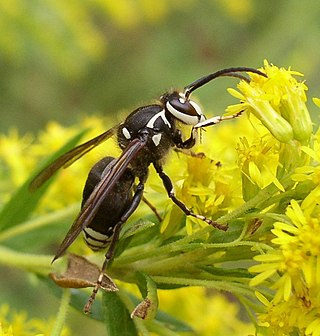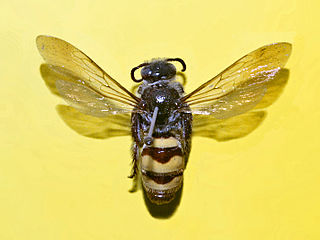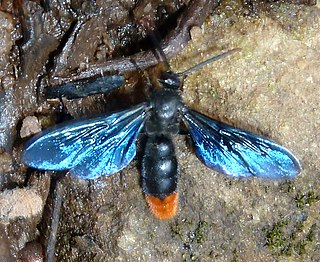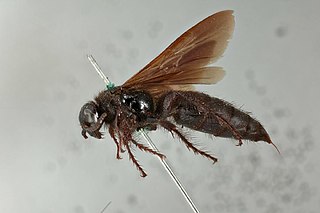
The Scoliidae, the scoliid wasps, are a family of wasps comprising about 560 species worldwide. They tend to be black, often marked with yellow or orange, and their wing tips are distinctively corrugated. Males are more slender and elongated than females, with significantly longer antennae, but the sexual dimorphism is not as apparent as in many of the Tiphiidae and Thynnidae.

Vespoidea is a superfamily of wasps in the order Hymenoptera. Vespoidea includes wasps with a large variety of lifestyles including eusocial, social, and solitary habits, predators, scavengers, parasitoids, and some herbivores.

Megascolia procer, the giant scoliid wasp, is a solitary wasp in the family Scoliidae found across Asia. It is one of the largest wasps in the world, with a wingspan of 11.6 cm (4.6 in).

Scolia dubia, also known as the two-spotted scoliid wasp or a blue-winged scoliid wasp, is a species in the family Scoliidae.

Synoeca is a genus of eusocial paper wasps found in the tropical forests of the Americas. Commonly known as warrior wasps or drumming wasps, they are known for their aggressive behavior, a threat display consisting of multiple insects guarding a nest beating their wings in a synchronized fashion, and an extremely painful sting. The sting is barbed and if used often kills the wasp, which may be the reason why such a striking defensive display is used. This display escalates from drumming inside the nest to hundreds of wasps moving on to the envelope of the nest and continuing to drum. If this does not deter the threat only then do the wasps begin to sting.

Scolia is a genus of scoliid wasps in the subfamily Scoliinae. There are over 200 described species in Scolia.

Campsomeris is a Neotropical genus of the family Scoliidae, also known as the scoliid wasps. They are generally parasites of beetle larvae, most often of Scarabaeidae.

Dielis trifasciata, also known as the three-banded scoliid wasp, is a species in the family Scoliidae.

The Thynnidae are a family of large, solitary wasps whose larvae are almost universally parasitoids of various beetle larvae, especially those in the superfamily Scarabaeoidea. Until recently, the constituents of this family were classified in the family Tiphiidae, but multiple studies have independently confirmed that thynnids are a separate lineage.

Scolia nobilitata, also known as the noble scoliid wasp, is a species of scoliid wasp in the family Scoliidae.

Pygodasis is a New World genus of wasps in the family Scoliidae, formerly treated as a subgenus within Campsomeris.

Xanthocampsomeris is a New World genus of the family Scoliidae, also known as the scoliid wasps, formerly treated as a subgenus within Campsomeris.

Campsomerini is a cosmopolitan tribe of the family Scoliidae. An older, alternative representation of this group is as a subfamily, Campsomerinae.

Pyrrhoscolia is a genus of scoliid wasps in the subfamily Scoliinae. It is native to the Afrotropics, where they have been recorded in various Afromontane regions. They are external parasitoids of beetle larvae. The wings of all three species are noted for their brilliant lustre.

Dielis plumipes, the feather-legged scoliid wasp, is a species of scoliid wasp in the family Scoliidae.

Dielis pilipes, the hairy-footed scoliid wasp, is a species of scoliid wasp in the family Scoliidae.

Triscolia ardens is a species of wasp in the family Scoliidae. It is the sole member of its genus found in North America outside of Mexico.

Scolia carbonaria is a species of wasp in the family Scoliidae.

Dielis tolteca, the Toltec scoliid wasp, is a species of hymenopteran in the family Scoliidae. It is commonly found on plants in the genus Solidago.

Dielis tejensis is a species of scoliid wasp. It is endemic to Texas.
































